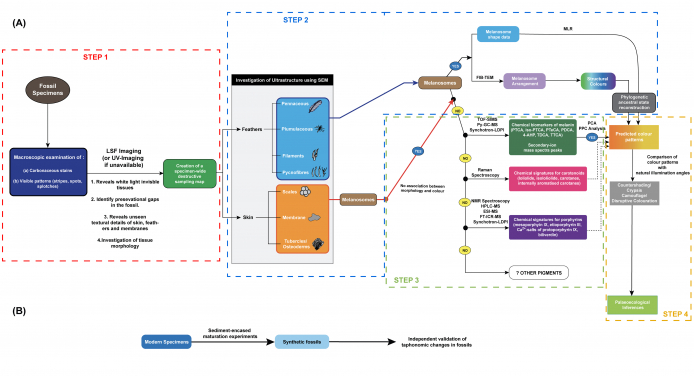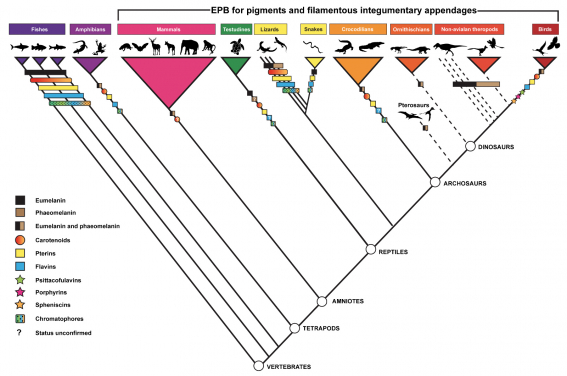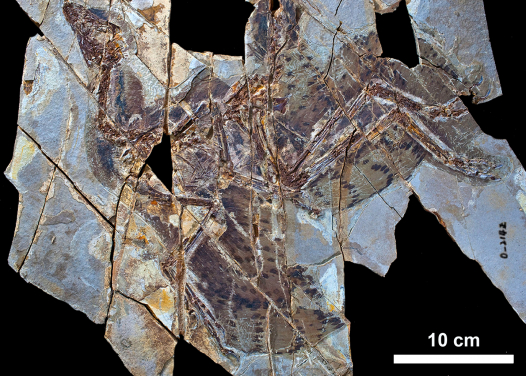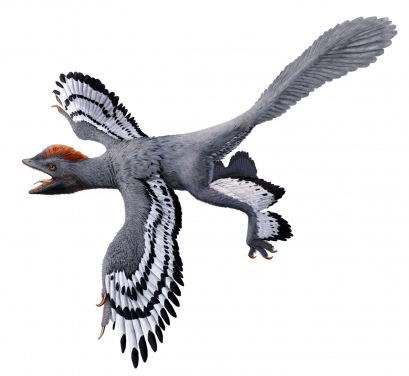Media
What colour were fossil animals?
HKU palaeontologists evaluate fossil colour reconstruction methods
to propose new study framework
20 Sep 2019

Figure 4. (A) New framework for reconstructing fossil colour in animals. Solid lines indicate confirmed steps; dashed lines indicate potentially useful steps that deserve further investigation. (B) Sediment-encased maturation is method of producing artificial fossils that helps to better understand how fossils are preserved. Abbreviations: ESI-MS, electrospray ionisation mass spectrometry; FIB-TEM, focused ion beam-transmission electron microscopy; FT-ICR-MS, Fourier-transform ion cyclotron resonance mass spectrometry; HPLC-MS, high performance liquid chromatography; LSF, Laser-Stimulated Fluorescence; MLR, multinomial logistic regression; NMR, nuclear magnetic resonance; PCA, principal components analysis; PPC, peak probability contrast; Py-GC-MS, pyrolysis-gas chromatography-mass spectroscopy; synchotron-LDPI, laser desorption-ionisation; TDCA, thiazole-4,5-dicarboxylic
acid; TOF-SIMS, time of flight secondary-ion mass spectroscopy; UV, ultra-violet light.

Figure 1. Distribution of different colour-producing pigments among vertebrate animals. Covers fishes, amphibians, mammals, lizards, snakes, crocodilians and extinct archosaurs including non-avialan dinosaurs and birds. Dotted lines indicate stem groups; bold lines indicate crown groups.

Figure 2. A pristine specimen of the feathered dinosaur Anchiornis huxleyi showing its colour patterns. Melanin was first identified from an animal from this species. Image Credit: Xiaoli Wang).

Figure 3. A life reconstruction of the feathered dinosaur Anchiornis huxleyi based on fossil evidence of its colour and patterning. This evidence included inferences about melanin pigments. Image credit: HKU MOOC / Julius T Csotonyi / Michael Pittman.

Figure 4. (A) New framework for reconstructing fossil colour in animals. Solid lines indicate confirmed steps; dashed lines indicate potentially useful steps that deserve further investigation. (B) Sediment-encased maturation is method of producing artificial fossils that helps to better understand how fossils are preserved. Abbreviations: ESI-MS, electrospray ionisation mass spectrometry; FIB-TEM, focused ion beam-transmission electron microscopy; FT-ICR-MS, Fourier-transform ion cyclotron resonance mass spectrometry; HPLC-MS, high performance liquid chromatography; LSF, Laser-Stimulated Fluorescence; MLR, multinomial logistic regression; NMR, nuclear magnetic resonance; PCA, principal components analysis; PPC, peak probability contrast; Py-GC-MS, pyrolysis-gas chromatography-mass spectroscopy; synchotron-LDPI, laser desorption-ionisation; TDCA, thiazole-4,5-dicarboxylic
acid; TOF-SIMS, time of flight secondary-ion mass spectroscopy; UV, ultra-violet light.
- 1 / 4
- 2 / 4
- 3 / 4
- 4 / 4
Dr Michael Pittman of the Vertebrate Palaeontology Laboratory, Department of Earth Sciences, The University of Hong Kong led an international study with his PhD student Mr Arindam Roy that evaluates fossil colour reconstruction methods to propose a new study framework that improves and expands current practice. The paper was recently published in the journal Biological Reviews.
“People are fascinated by the colour and pattern of dinosaurs and other extinct animals because these aspects can tell you so much about an animal. Just think of a zebra and a peacock. We evaluated everything we know about fossil and modern animal colour and used that knowledge to propose a framework to improve how we reconstruct fossil colour in the future.” said Dr Pittman.
Colour and patterns are critical to understanding the life, ecology, physiology and behaviour of animals. These colours are produced when light interacts with pigments and the structure of animal tissue. Common naturally-occurring animal pigments include melanin, carotenoids, porphyrins pterins, flavins and psittacofulvins which produce colours ranging from black and grey to yellow, orange and green (Figure 1).
Feathered dinosaur fossils instrumental to understanding the origin of birds were the first animal fossils to yield evidence of melanin, the colour pigment we also have in our eyes and hair (Figures 2, 3). In the last ten years, colour patterns have been reconstructed in over 30 fossil animals including birds, non-avialan dinosaurs and mammals, providing a unique opportunity to test ecological and behavioral hypotheses that were previously out of reach. Unfortunately, our knowledge of other pigments is scarce in the fossil record as these non-melanin pigments are more difficult to fossilise. This incomplete knowledge and the lack of a standard study approach have been prevailing challenges to the reconstruction of colour in fossil animals.
Co-author Dr Evan Saitta of the Field Museum of Natural History, Chicago, USA said, “We are in the golden age of multidisciplinary techniques in palaeontology. This is the first comprehensive study that not only critically evaluates the currently available methods, but also provides a reliable and repeatable framework that covers all vertebrate pigment systems not just melanin alone.”
The new palaeocolour reconstruction framework proposed by Dr Michael Pittman, Mr Arindam Roy and their international team (Figure 4) comprises four main steps: (1) Map the known or suspected extent of preserved colour and patterns in the specimen; (2) Search for pigment-bearing microstructures using electron microscopy e.g. microstructure shape can be used to identify melanin-based colours like black, grey and brown); (3) If melanin-based colours are not detected, use high-end chemical analysis techniques to detect biomarkers of other pigments (4) Use reconstructed colours and patterns to test fundamental hypotheses related to animal physiology, ecology and behaviour. The new framework overcomes past challenges by incorporating the chemical signatures of different pigments, large and small-scale anatomical details visible in fossils as well as the potential for different pigments to fossilise. This framework provides background context for the evolution of colour-producing mechanisms and is expected to encourage future efforts to reconstruct colour in more fossil animals including non-dinosaur reptiles and mammals.
Mr Roy, the study’s first author and a Hong Kong PhD Fellow said, “I am really excited by the course we have charted in this review study as I will be tackling many of the key issues we identified during my PhD studies at HKU.”
The paper: A Roy, M Pittman, E T Saitta, T G Kaye and X Xu. Recent advances in amniote palaeocolour reconstruction and a framework for future research. Biological Reviews.
Link to journal article: https://onlinelibrary.wiley.com/doi/10.1111/brv.12552
For media enquiries, please contact Ms Cindy Chan, Assistant Director of Communications of HKU Faculty of Science (Tel: 3917-5286/6703-0212; email: cindycst@hku.hk) or Dr Michael Pittman, Research Assistant Professor of HKU Earth Sciences (email: mpittman@hku.hk).
Video download
Image download:
https://www.scifac.hku.hk/press
